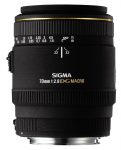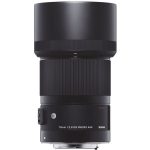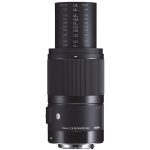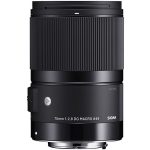Announced
Production status
Original name
Pros and cons
Genres or subjects of photography
Recommended slowest shutter speed when shooting static subjects handheld
Sigma 70mm F/2.8 DG Macro | A
Macro lens • Digital era
Abbreviations
| DG | The lens is designed for 35mm digital cameras but can be also used on APS-C digital cameras. |
| MACRO | Macro lens. Designed specially for shooting close-ups of small subjects but can be also used in other genres of photography, not necessarily requiring focusing at close distances. Learn more |
| | A | Belongs to the Art series lenses. |
Model history
| ■Sigma 70mm F/2.8 EX DG Macro • 1:1 | A | 10 - 9 | 0.26m | ⌀62 | 2006 ● | |
| ■Sigma 70mm F/2.8 DG Macro | A • 1:1 | A | 13 - 10 | 0.26m | ⌀49 | 2018 ● | |
Specification


| Optical design: | |
| 70mm | |
| F/2.8 | |
| 35mm full frame | |
| Canon EF [44mm] | |
| Sigma SA [44mm] | |
| 34.3° (35mm full frame) | |
| 13 elements in 10 groups | |
| 2 ASPH, 2 FLD, 2 SLD | |
| Floating element system | |
| On Canon EOS APS-C [1.59x] cameras: | |
35mm equivalent focal length: | 111.3mm (in terms of field of view) |
35mm equivalent speed: | F/4.5 (in terms of depth of field) |
Diagonal angle of view: | 22° |
| On Sigma SD APS-C [1.74x] cameras: | |
35mm equivalent focal length: | 121.8mm (in terms of field of view) |
35mm equivalent speed: | F/4.9 (in terms of depth of field) |
Diagonal angle of view: | 20.1° |
| Diaphragm mechanism: | |
Diaphragm type: | Automatic |
Aperture control: | None; the aperture is controlled from the camera |
| 9 (nine) | |
| Focusing: | |
| 0.258m | |
| 1:1 | |
Focusing modes: | Autofocus, manual focus |
Autofocus motor: | Micromotor |
Manual focus control: | Focusing ring |
Focus mode selector: | AF - MF |
Manual focus override in autofocus mode: | Yes |
Focusing distance range limiter: | FULL;0.258-0.5;0.5- |
| Optical Stabilizer (OS): | |
| - | |
| Physical characteristics: | |
| 515g (Sigma SA) | |
| ⌀70.8×105.8mm (Sigma SA) | |
| Water-resistant mount | |
| - | |
| Accessories: | |
| Screw-type 49mm | |
| LH708-01 - Bayonet-type round | |
| Sigma Tele Converter TC-1401 → 98mm F/3.9 | |
| Sigma Tele Converter TC-2001 → 140mm F/5.6 |
Source of data
- Manufacturer's technical data.
Manufacturer description
In recent years, macro lenses in the standard range have tended to employ inner focusing with the goal of maximizing autofocus speed. In contrast, the new SIGMA 70mm F2.8 DG MACRO | Art lens is designed to prioritize optical performance, fulfilling the demanding image quality requirements that define the Art line. In the standard to mid-telephoto range, it delivers stunning resolution and incredible clarity that greatly exceed expectations for a macro lens. The coreless DC motor further enhances image quality, while an optimized algorithm helps offer extremely smooth autofocus performance for a weightier, high-performance lens. Photography enthusiasts will recall a certain legendary, razor-sharp macro lens—the SIGMA MACRO 70mm F2.8 EX DG—and be glad to learn it is available in a new form, updated with outstanding Art line quality.
In order to realize top-level performance at every shooting distance, the lens features an extending, floating, two-group focus mechanism. This configuration minimizes aberration to produce optimal results at any focus distance. To minimize axial chromatic aberration, the optical system incorporates two FLD glass elements, two SLD glass elements, and one element with a high rate of anomalous partial dispersion and a high index of refraction. In addition, two aspherical lens elements help increase resolution at close shooting distances. This optical system makes possible a razor-sharp in-focus area contrasted with a bokeh area free of color streaking.
The focus-by-wire system eliminates the direct mechanical connection between the focus ring and the focus drive system. Controlled by SIGMA’s latest algorithm, a newly developed coreless DC motor adjusts focus with optimal speed and low noise. Full-time manual focus is available even during autofocus, allowing the photographer to make minute focus adjustments simply by turning the focus ring. In addition, the focus ring’s large angle of rotation helps the photographer achieve the extremely precise focusing required for effective macro photography.
Full-time manual focus function allows the lens to be switched to manual focus simply by rotating the focus ring.
The lens mount incorporates rubber sealing※ to protect the mount from dust and water drops.
* Except for SIGMA mount
The 9-blade rounded diaphragm creates an attractive blur in the out-of-focus areas of the image.
The Canon mount version of this lens is compatible with the Canon Lens Aberration Correction function.* Matching the optical characteristics of the lens, this function performs in-camera corrections of peripheral illumination, chromatic aberrations, distortion, and more, to further enhance image quality.
Exclusively for SIGMA 70mm F2.8 DG MACRO | Art, the 65mm MACRO FLASH ADAPTER makes the lens compatible with ELECTRONIC FLASH MACRO EM-140 DG (both accessories sold separately). Thanks to the 72mm filter thread, a 72mm adapter can also be added so as to accommodate macro flashes other than EM-140 DG as well as ring lights.
The lens is compatible with SIGMA TELE CONVERTERS (sold separately) designed for the company’s new lens lines. SIGMA TELE CONVERTER TC-1401 allows the lens to be used as a 98mm F4 mid-telephoto macro with autofocus functionality,* while SIGMA TELE CONVERTER TC-2001 allows the lens to be used as a 140mm F5.6 mid-telephoto macro with manual focus.
* Autofocus available at 0.5m to infinity.
From the editor
In recent years, macro lenses in the standard range have tended to employ inner focusing with the goal of maximizing autofocus speed. In contrast, the SIGMA 70mm F/2.8 DG MACRO | Art lens is designed to prioritize optical performance, fulfilling the demanding image quality requirements that define the Art line.
***
Please note that this lens was also released for mirrorless camera mounts. We decided to record it separately in our database.
Lenses with similar focal length
| ■Canon EF mount (1) | |||||||||
| Sigma 70mm F/2.8 EX DG Macro • ⌀62 • 1:1 @ 0.257m | 2006 ● | Compare | 0 | 4 | |||||

NOTE: Approximate weight and length were used for comparison purposes. |
|||||||||
| ■Sigma SA mount (1) | |||||||||
| Sigma 70mm F/2.8 EX DG Macro • ⌀62 • 1:1 @ 0.257m | 2006 ● | Compare | 0 | 4 | |||||

|
|||||||||



